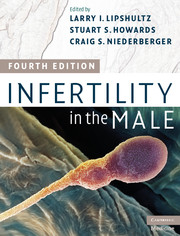Crossref Citations
This Book has been
cited by the following publications. This list is generated based on data provided by Crossref.
Wald, Moshe
2011.
An Introduction to Male Reproductive Medicine.
p.
103.
Meacham, Randall B.
2011.
An Introduction to Male Reproductive Medicine.
p.
77.
Williams, Daniel H.
2011.
An Introduction to Male Reproductive Medicine.
p.
58.
Centola, Grace M.
2011.
An Introduction to Male Reproductive Medicine.
p.
121.
Niederberger, Craig
2011.
An Introduction to Male Reproductive Medicine.
p.
29.
Caroppo, Ettore
2011.
An Introduction to Male Reproductive Medicine.
p.
1.
Brannigan, Robert E.
2011.
An Introduction to Male Reproductive Medicine.
p.
84.
Eisenberg, M. L.
Hsieh, T.‐C.
and
Lipshultz, L. I.
2013.
The relationship between anogenital distance and age.
Andrology,
Vol. 1,
Issue. 1,
p.
90.
Maartens, Pieter Johann
Flint, Margot
and
du Plessis, Stefan S.
2014.
Male Infertility.
p.
211.
Thomsen, Ruth
2014.
Non-invasive collection and analysis of semen in wild macaques.
Primates,
Vol. 55,
Issue. 2,
p.
231.
Sheu, Geraldine
Revenig, Louis M.
and
Hsiao, Wayland
2014.
Men's Sexual Health and Fertility.
p.
13.
Gangrade, Bhushan K.
Patel, Zamip
and
Patel, Sejal Dharia
2015.
Unexplained Infertility.
p.
335.
Maartens, Pieter Johann
Aboua, Yapo Guillaume
and
Plessis, Stefan S.
2015.
Unexplained Infertility.
p.
121.
Nakata, Hiroki
Wakayama, Tomohiko
Takai, Yoshimi
and
Iseki, Shoichi
2015.
Quantitative Analysis of the Cellular Composition in Seminiferous Tubules in Normal and Genetically Modified Infertile Mice.
Journal of Histochemistry & Cytochemistry,
Vol. 63,
Issue. 2,
p.
99.
Jiménez-Reina, Luis
Maartens, Pieter Johann
Jimena-Medina, Ignacio
Agarwal, Ashok
and
du Plessis, Stefan S.
2016.
Exercise and Human Reproduction.
p.
1.
Kohn, Taylor P.
Kohn, Jaden R.
Darilek, Sandra
Ramasamy, Ranjith
and
Lipshultz, Larry
2016.
Genetic counseling for men with recurrent pregnancy loss or recurrent implantation failure due to abnormal sperm chromosomal aneuploidy.
Journal of Assisted Reproduction and Genetics,
Vol. 33,
Issue. 5,
p.
571.
Kalejaiye, Odunayo
and
Muneer, Asif
2017.
The Diagnosis and Treatment of Male Infertility.
p.
79.
Ventimiglia, E.
Ippolito, S.
Capogrosso, P.
Pederzoli, F.
Cazzaniga, W.
Boeri, L.
Cavarretta, I.
Alfano, M.
Viganò, P.
Montorsi, F.
and
Salonia, A.
2017.
Primary, secondary and compensated hypogonadism: a novel risk stratification for infertile men.
Andrology,
Vol. 5,
Issue. 3,
p.
505.
2017.
A Practical Guide to Sperm Analysis.
p.
169.
Raheem, Omer A.
and
Hsieh, Tung-Chin
2018.
Intracytoplasmic Sperm Injection.
p.
123.





